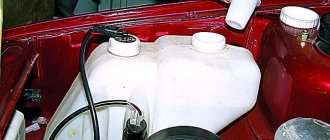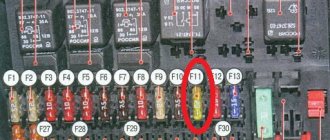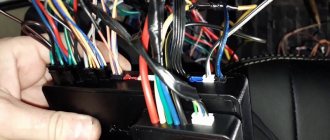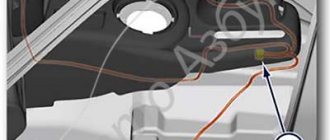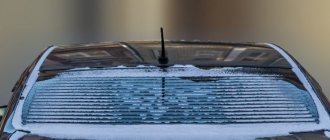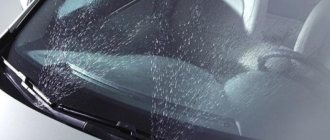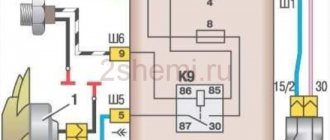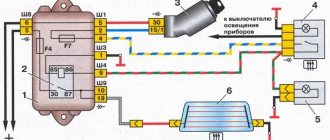Fuses and relays are designed to protect power units and vehicle circuits from short circuits or overloads.
If any mechanism in the car stops working, first of all you need to check the fuses. Perhaps the problem lies there.
In the sedan, station wagon and hatchback versions, the fuse blocks are located in the same places. The connection diagram and arrangement of elements are identical.
Engine compartment
Finding the location under the hood is easy. It is located between the battery and the antifreeze reservoir of the engine cooling system.
To protect against water and dust, the fuses are covered with a plastic cover (black). The housing cover is secured with two latches. Dismantling is done by hand - you need to unclip the clamps.
It looks like this inside:
It is strictly forbidden to remove fuses by swinging them. This action may break the legs of the insert. For dismantling, tweezers or a flat clamp are used.
Interpretation of engine compartment fuses
According to the diagram, each fuse is responsible for a specific circuit, which allows minimizing the load on it. This also prevents the simultaneous failure of several vehicle circuits.
| № | Designation | Power, A | What is he responsible for? |
| A - tweezers for removing fuses | FUSE PULLER* | ||
| Ef1 | WATT MAIN | 30 | Hazard alarm, anti-theft control unit, diagnostic connector, rear fog lights, clock, air conditioning system, air conditioning switch, audio system, immobilizer, automatic transmission control unit |
| Ef2 | ABS | 60 | ABS control unit, ABS control unit |
| Ef3 | BLOWERMOTOR | 30 | Air conditioning fan |
| Ef4 | IGN-2 | 30 | Electric windows, electric rear view mirrors, starter |
| Ef5 | IGN-1 | 30 | Fuel pump switch relay, engine control unit, exhaust gas recirculation valve, ignition system, fuel pump, evaporative emission canister purge valve, engine cooling fan |
| Ef6 | ELEC FAN LO | 20 | Engine cooling fan (low speed) |
| Ef7 | DEFOG | 30 | Heated rear window |
| Ef8 | ELEC FAN HI | 30 | Engine cooling fan (high speed) |
| Ef9 | POWER WINDOW | 20 | Power windows (except driver's door) |
| Ef10 | DIS | 15 | Fuel pump switch relay, electronic engine control unit, exhaust gas recirculation valve, ignition system |
| Ef11 | ECM | 10 | Main relay power circuit |
| Ef12 | HEADLAMP | 25 | Headlights, instrument and control lighting |
| Ef13 | STOP | 15 | Brake signal |
| Ef14 | DR'S P/WDO | 20 | Power windows (driver's door) |
| Ef15 | H/L HI | 15 | High beam headlights |
| Ef16 | HORN | 15 | Sound signal |
| Ef17 | A/C | 10 | Air conditioning compressor |
| Ef18 | FUEL PUMP | 15 | Fuel pump power supply circuit |
| Ef19 | PASS F/BOX | 15 | Instrument cluster, horn switch, power folding mirrors, dome light, interior light, trunk light, trunk lid open sensor |
| Ef20 | H/L LO LH | 10 | Low beam (left headlight) |
| Ef21 | EMS | 15 | Evaporative emission canister purge valve, heated oxygen sensor, engine cooling fan |
| Ef22 | INJECTOR | 15 | Injectors, exhaust gas recirculation system |
| Ef23 | IL LH | 10 | License plate lights, hazard warning lights, tail light, block headlight (left side) |
| Ef24 | FOG | 15 | Fog lights |
| Ef25 | WORLD HEAT | 10 | Electric drive and heated rear view mirrors |
| Ef26 | DOOR LOCK | 15 | Central locking system |
| Ef27 | H/L LO RH | 10 | Low beam (right headlight) |
| Ef28 | IL RH | 10 | License plate lights, hazard warning lights, tail light, block headlight (right side) |
| Ef29 | SPARE | 10 | Not used |
| Ef30 | SPARE | 15 | Not used |
| Ef31 | SPARE | 25 | Not used |
Decoding the engine compartment relay
Next to the fuses of the engine compartment module there are relays that are responsible for the operation of a number of electrical devices or mechanisms.
Explanation:
| № | Designation | vendor code | What is he responsible for? |
| 1 | ILLUMINATION RELAY | 96190187 | Illumination of instruments and controls |
| 2 | HORN RELAY | 96190187 | Sound signal |
| 3 | MAIN RELAY | 96190189 | Main relay/ignition relay |
| 4 | HEAD LAMP RELAY | 96190189 | Block lights |
| 5 | FRT FOG RELAY | 96190187 | Fog lights |
| 6 | A/C COMP RELAY | 96190187 | A/C compressor clutch |
| 7 | FUEL PUMP RELAY | 96190189 | Fuel pump, ignition coils |
| 8 | POWER WINDOW RELAY | 96190189 | Electric windows |
| 9 | ELEC FAN LO RELAY | 96190189 | Electric fan of the engine cooling system (low speed) |
| 10 | DEFOG RELAY | 96190189 | Heated rear window |
| 11 | ELEC FAN HI RELAY | 96190189 | Electric engine cooling fan (high speed) |
Purpose of the Chevrolet Lacetti relay
| № | Designation | Purpose |
| 1 | ILLUMINATION RELAY | Illumination of controls and instruments |
| 2 | HORN RELAY | Horn relay |
| 3 | MAIN RELAY | Main Relay / Ignition Relay |
| 4 | HEAD LAMP RELAY | Head light relay |
| 5 | FRT FOG RELAY | Front fog lamp relay |
| 6 | A/C COMP RELAY | A/C compressor clutch |
| 7 | FUEL PUMP RELAY | Chevrolet Lacetti fuel pump relay |
| 8 | POWER WINDOW RELAY | Window lifters |
| 9 | ELEC FAN LO RELAY | Cooling Fan - Low Speed |
| 10 | DEFOG RELAY | Electric heated rear window |
| 11 | ELEC FAN HI RELAY | Cooling Fan - High Speed |
Salon
In the cabin, the fuses are located on the left side of the dashboard. To provide access to the fuse links, you must first remove the cover.
The cabin relays are located on a special bracket under the panel near the pedals. To gain free access to them, you need to remove the lower panel trim by first unscrewing two screws from the compartment for small items and removing the handle to open the hood.
Decoding the interior fuses
| № | Designation | Power, A | What is he responsible for? |
| F1 | AIRBAG | 10 | Airbag computer |
| F2 | ESM | 10 | Engine ECU, Automatic Transmission ECU*, Alternator, Vehicle Speed Sensor |
| F3 | TURN SIGNAL | 15 | Hazard warning switch, direction indicators |
| F4 | CLUSTER | 10 | Instrument panel, electronic low beam*, horn, brake light switch, electronic variable power steering*, air conditioning switch* |
| F5 | — | — | not used |
| F6 | ENG FUSE | 10 | Air conditioning compressor relay, heated rear window relay, power window relay, headlight relay |
| F7 | HVAC | 20 | Air conditioning fan switch relay, air conditioning switch, climate control system* |
| F8 | SUNROOF | 15 | Power mirror switch, power folding mirrors*, power sunroof* |
| F9 | WIPER | 25 | Wiper gear motor, wiper operating mode switch |
| F10 | HANDS FREE | 10 | |
| F11 | ABS | 10 | ABS control unit. ABS executive unit |
| F12 | IMMOBILIZER | 10 | Immobilizer, anti-theft alarm ECU, rain sensor |
| F13 | those | 10 | Automatic transmission control unit* |
| F14 | HAZARD | 15 | Hazard switch |
| F15 | ANTI-THEFT | 15 | Anti-theft alarm control unit |
| F16 | DIAGNOSIS | 10 | Diagnostic connector |
| F17 | AUDIO/CLOCK | 10 | Audio system, clock |
| F18 | EXTRA JACK | 15 | Additional socket |
| F19 | CIGAR LIGHTER | 15 | Cigarette lighter fuse |
| F20 | BACK-UP | 10 | Reversing light switch, automatic transmission mode selector |
| F21 | REAR FOG | 15 | Relay for turning on rear fog lights, relay for illumination of instruments and controls, side lighting |
| F22 | ATC/CLOCK | 15 | Clock, climate control system, air conditioning switch* |
| F23 | AUDIO | 15 | Audio system |
| F24 | IMMOBILIZER | 10 | Immobilizer |
What to do if the instrument lights do not light up
Decoding the interior relay
Depending on the modification, the car may additionally contain a relay for climate control and forced head lighting.
| № | vendor code | What is he responsible for? |
| 1 | no data | Battery protection system control unit |
| 2 | 96312545 | Turn signal switch |
| 3 | 96344573 | Relay for turning on fog lights in rear lights |
| 4 | no data | Starter Interlock Relay (for vehicles with automatic transmission) |
| — | 96190189 | Park/Neutral Relay |
| — | 96190189 | Fan relay |
| — | 96190189 | Headlight warning light relay (daytime running lights) |
Where are the Chevrolet Lacetti fuses located under the hood?
Under the hood of Chevrolet Lacetti cars, they are located on the right side near the battery, under a black cover. In the picture this block is o.
To access the fuses, you need to press a special latch:
Relay and fuse diagram under the hood of Chevrolet Lacetti
The importance of the rear wiper
Rear wiper installed on a car.
Because the rear wiper serves as a glass cleaner, which on all station wagon and hatchback vehicles gets clogged more than on sedans. It happened this way due to the close proximity to the road surface, the importance of this device is undeniable .
The Lacetti does not start, the relay clicks, the starter does not turn
If the car does not start after the relay is activated, there may be several factors.
- The battery is dead. There is often not enough charge in the battery to move the starter armature.
- The motor windings are burnt out. If the thrower breaks down, it may need to be completely replaced.
- The contact of power supply lines has decreased. The damaged area must be descaled and repaired.
- There is no contact between the relay power terminals and the starter. Repair is carried out by replacing the relay or re-sealing the contact group.
Removing and installing blocks
Before the procedure, you need to disconnect the battery.
Checking Chevrolet Lacetti fuses with a multimeter
Chevrolet Lacetti fuses have a transparent body; in most cases there is no need to use instruments to monitor them. It is enough to visually inspect the condition of the fuse element and it will be clear whether it is useful or blown.
Testing of car fuses with instruments is carried out only in cases where the case material or design features do not allow the performance to be determined “by eye”; the use of a tester or indicator will be required.
- Remove the fuse from its socket and lightly clean the contacts if necessary.
- Before checking the fuse with a tester, you must study the instructions for use. Connect both fuses according to the instructions on the device. When working with a tester, you must set the device to test resistance. If the fuse is good, the device will indicate a short circuit. If the indicator is used with a good fuse, the indicator will light up.
- A faulty fuse must be replaced with a new one. A prerequisite is that the technical characteristics of the new product must correspond to the recommended parameters.
If the device’s functionality has not been restored, then you need to look for other reasons for the failure. This may be an open circuit or a malfunction of the device itself. Further troubleshooting is much more difficult and is best carried out at specialized service stations. Unqualified intervention in the electrical system of a car can cause very unpleasant consequences.
